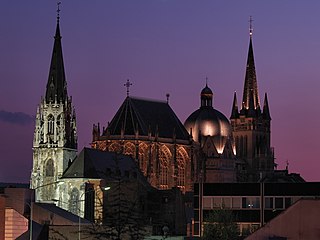
Aachen is, with around 249,000 inhabitants, the 13th-largest city in North Rhine-Westphalia, and the 27th-largest city of Germany.

Aachen Cathedral is a Roman Catholic church in Aachen, Germany and the seat of the Roman Catholic Diocese of Aachen.

The Imperial Regalia, also called Imperial Insignia, are regalia of the Holy Roman Emperor. The most important parts are the Crown, the Imperial orb, the Imperial sceptre, the Holy Lance and the Imperial Sword. Today they are kept at the Imperial Treasury in the Hofburg palace in Vienna, Austria.
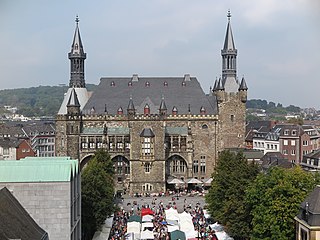
Aachen Town Hall is a landmark of cultural significance located in the Altstadt of Aachen, Germany. It was built in the Gothic architecture style in the first half of the 14th century.
The Proserpina sarcophagus is a Roman marble sarcophagus from the first quarter of the third century AD, in which Charlemagne was probably interred on 28 January 814 in Aachen cathedral. It is displayed today in the Aachen Cathedral Treasury.

The Barbarossa Chandelier was made on the order of Emperor Frederick I, nicknamed Barbarossa, and his wife Beatrice sometime between 1165 and 1170 and was installed under the cupola of the Palatine Chapel in Aachen Cathedral. The chandelier was a donation in honour of Mary, Mother of God, the patroness of Aachen Cathedral and simultaneously represented a tribute to the builder of the cathedral, Charlemagne.
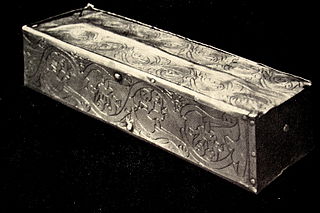
The Noli me tangere casket was a small silver-gilt casket made in 1356 for the Aachen Cathedral Treasury. It measured 15.2 cm in length, 3.7 cm in height and 4.8 cm in width. The casket was kept in the Marienschrein together with the key relics of the cathedral until the nineteenth century and the casket remained in the possession of the cathedral treasury until its destruction during the Second World War.

The Throne of Charlemagne is a throne erected in the 790s by Charlemagne, as one of the fittings of his palatine chapel in Aachen and placed in the Octagon of the church. Until 1531, it served as the coronation throne of the King of the Romans, being used at a total of thirty-one coronations. As a result, especially in the eleventh century, it was referred to as the totius regni archisolium. Charlemagne himself was not crowned on this throne, but instead in the Old St. Peter's Basilica in Rome by Pope Leo III in 800 AD.

The Bust of Charlemagne is a reliquary from around 1350 which contains the top part of Charlemagne's skull. The reliquary is part of the treasure kept in the Aachen Cathedral Treasury. Made in the Mosan region, long a centre of high-quality metalwork, the bust is a masterpiece both of late Gothic metalwork and of figural sculpture.

The Aachen Altar or Passion Altar (Passionsaltar) is a late gothic passion triptych in the Aachen Cathedral Treasury, made by the so-called Master of the Aachen Altar around 1515/20 in Cologne.

The Liuthar Gospels are a work of Ottonian illumination which are counted among the masterpieces of the period known as the Ottonian Renaissance. The manuscript, named after a monk called Liuthar, was probably created around the year 1000 at the order of Otto III at the Abbey of Reichenau and lends its name to the Liuthar Group of Reichenau illuminated manuscripts. The backgrounds of all the images are illuminated in gold leaf, a seminal innovation in western illumination.
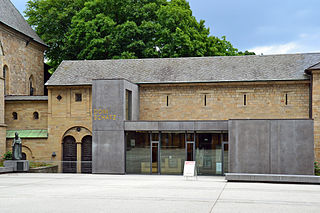
The Essen Cathedral Treasury is one of the most significant collections of religious artworks in Germany. A great number of items of treasure are accessible to the public in the treasury chamber of Essen Minster. The cathedral chapter manages the treasury chamber, not as a museum as in some places, but as the place in which liturgical implements and objects are kept, which continued to be used to this day in the service of God, so far as their conservation requirements allow.
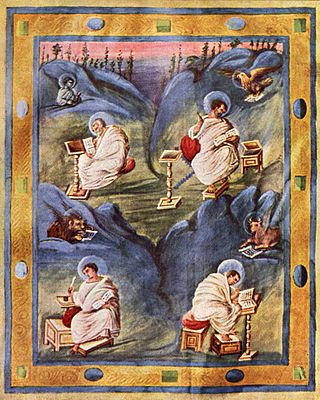
The Aachen Gospels are a Carolingian illuminated manuscript which was created at the beginning of the ninth century by a member of the Ada School. The Evangeliary belongs to a manuscript group which is referred to as the Ada Group or Group of the Vienna Coronation Gospels. It is part of the church treasury of Charlemagne's Palatine Chapel, now Aachen Cathedral, and is today kept in the Aachen Cathedral Treasury. The Treasury Gospels and the more recent Ottonian Liuthar Gospels are the two most significant medieval manuscripts on display there.

The notname Master of the Aachen Altar is given to an anonymous late gothic painter active in Cologne between 1495 and 1520 or 1480 and 1520, named for his master work, the Aachen Altar triptych owned by the Aachen Cathedral Treasury. Along with the Master of St Severin and the Master of the legend of St. Ursula he is part of a group of painters who were active in Cologne at the beginning of the sixteenth century and were Cologne's last significant practitioners of late gothic painting.

The so-called Sabre of Charlemagne is an early sabre of Hungarian (Magyar) type which has exceptionally been preserved as part of the Aachen regalia of the Holy Roman Empire. Along with the rest of the imperial regalia from both Aachen and Nuremberg, it is now kept in the Hofburg Palace, Vienna.

The Ambon of Henry II, commonly known as Henry's Ambon (Heinrichsambo) or Henry's Pulpit (Heinrichskanzel) is an ambon in the shape of a pulpit built by Henry II, Holy Roman Emperor in the Palatine chapel in Aachen between 1002 and 1014. It is among the most significant artworks of the Ottonian period.

The Hildesheim Cathedral Museum is the treasury and diocesan museum of Hildesheim, which illustrates over a thousand years of art and church history in Lower Saxony. It is located in historic rooms off the southern transept of the Hildesheim Cathedral. During the cathedral renovations of 2010, the nearby church of St Antonius and part of the cathedral cloisters were converted into display rooms for the museum.

A church treasury or church treasure is the collection of historical art treasures belonging to a church, usually a cathedral or monastery. Such "treasure" is usually held and displayed in the church's treasury or in a diocesan museum. Historically the highlight of church treasures was often a collection of reliquaries.
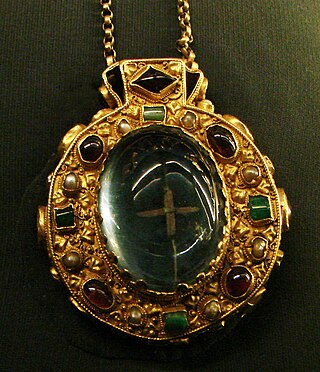
The Talisman of Charlemagne is a 9th-century Carolingian reliquary encolpion that may once have belonged to Charlemagne and is purported to contain a fragment of the True Cross. It is the only surviving piece of goldwork which can be connected with Charlemagne himself with some degree of probability, but the connection has been seriously questioned. The talisman is now kept in Rheims in the Palace of Tau.

The Trier Cathedral Treasury is a museum of Christian art and medieval art in Trier, Germany. The museum is owned by the Roman Catholic Diocese of Trier and is located inside the Cathedral of Trier. It contains some of the church's most valuable relics, reliquaries, liturgical vessels, ivories, manuscripts and other artistic objects. The history of the Trier church treasure goes back at least 800 years. In spite of heavy losses during the period of the Coalition Wars, it is one of the richest cathedral treasuries in Germany. With the cathedral it forms part of a UNESCO World Heritage Site.





















